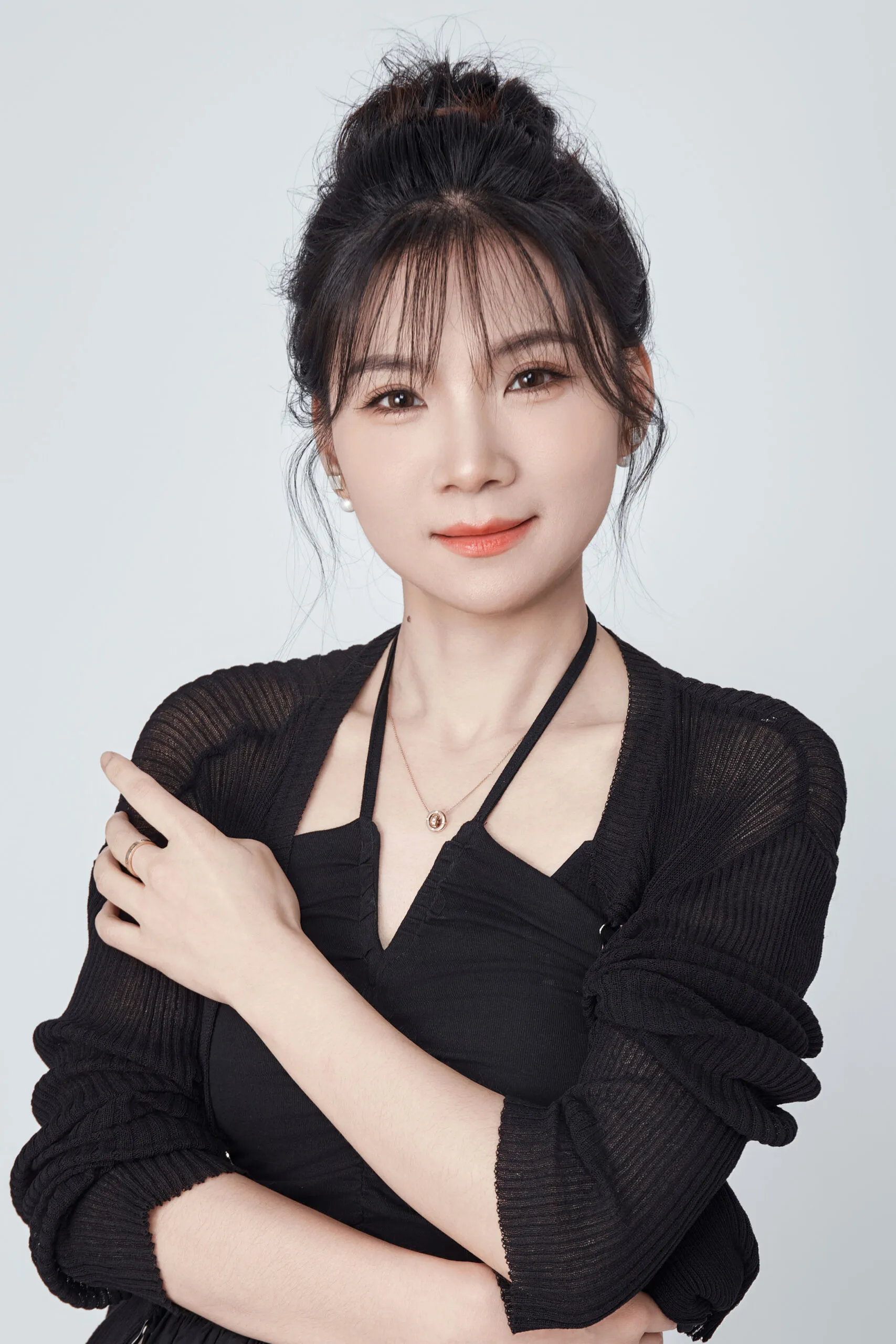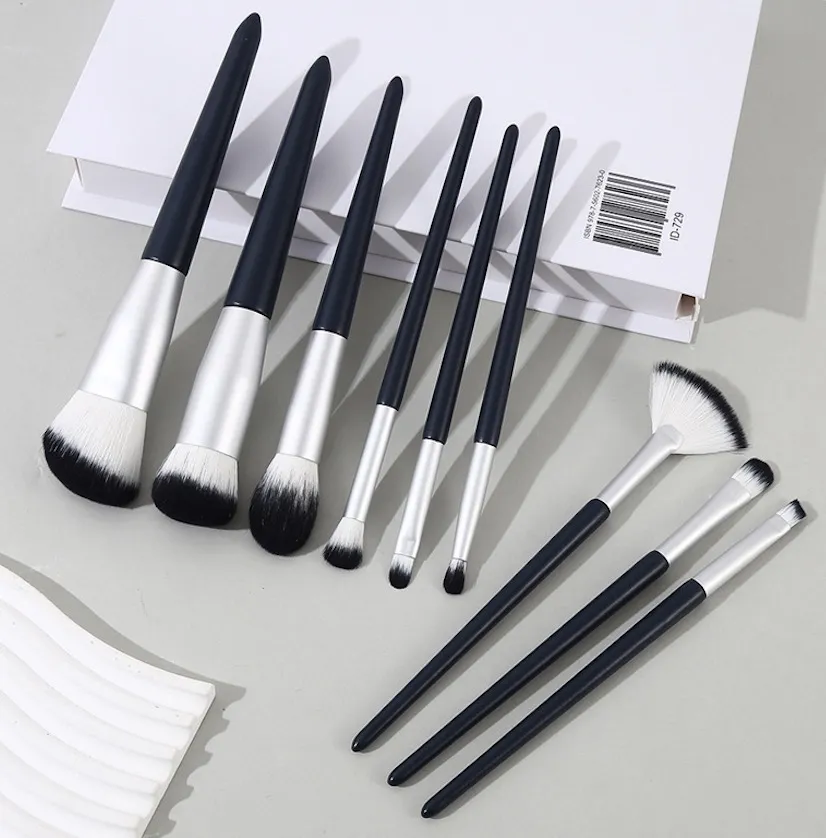Choosing between natural and Synthetic brushes1 feels overwhelming. A wrong move can hurt your product’s performance and your brand’s reputation. This guide makes the decision clear and strategic.
Natural hair brushes2, made from fibers like goat or squirrel, use their natural cuticles to pick up and blend powders for a seamless finish. Brands should choose them for powder products, while reserving synthetics for liquids, creams, and strict vegan claims. This choice impacts performance, cost, and marketing.
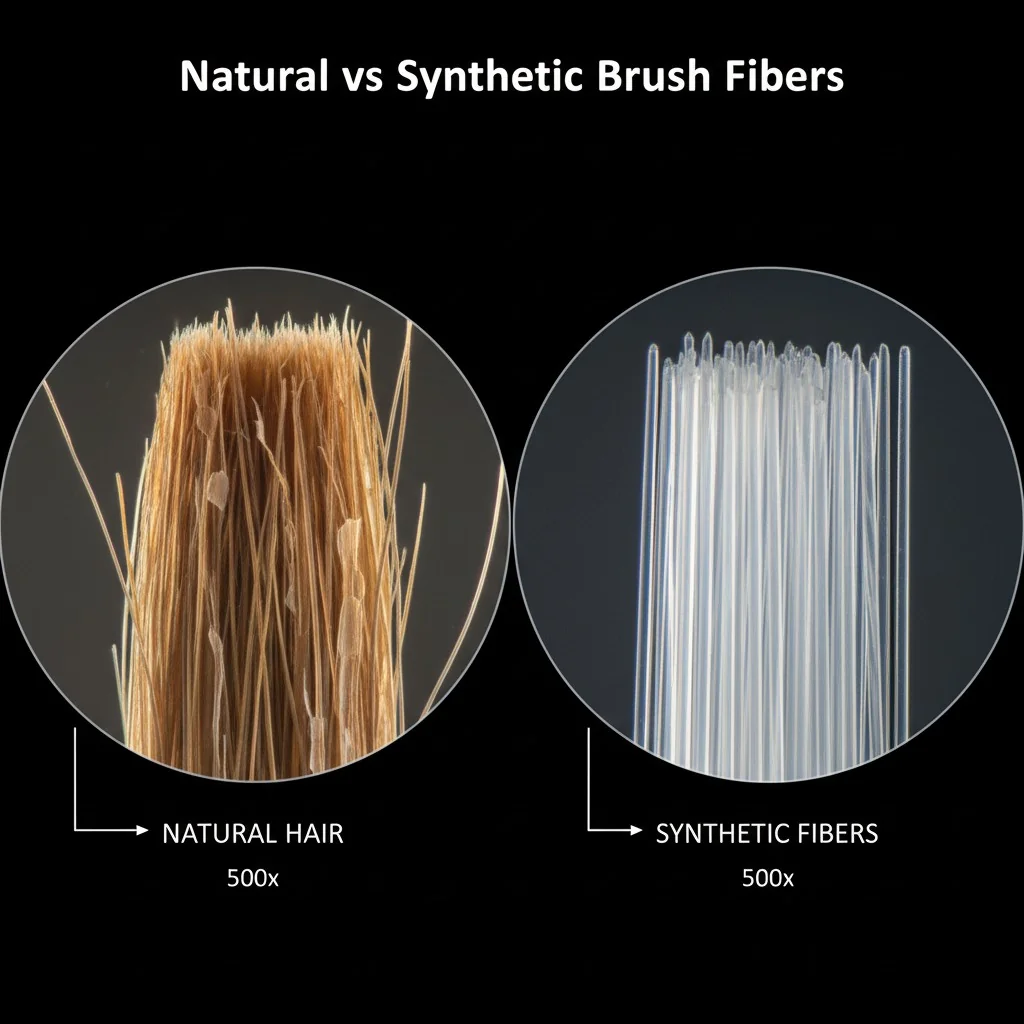
When I first started on the factory floor, the most important lesson I learned was that the soul of a brush is its hair. The wrong fiber can make even the best formula look patchy or unblended. For brand founders like you, this isn’t just about aesthetics; it’s about delivering on the promise you make to your customers with every product you launch.
Understanding the nuances between different fibers is the first step to creating a brush line that not only looks beautiful but performs flawlessly. Let’s break down what makes natural hair special and how you can leverage it for your brand.
All natural hair brushes are made by harming animals.Faux
This is a common misconception. Many high-quality natural hairs, like goat hair, are collected by shearing the animal, similar to a haircut, which does not cause harm. Responsible sourcing and transparency are key.
The microscopic cuticles on natural hair fibers are what make them excellent for applying powder.Vrai
These tiny, overlapping scales on the hair shaft grab onto powder pigments and release them gradually onto the skin. This action creates the soft, diffused, and seamlessly blended finish that natural brushes are famous for.
What are natural hair makeup brushes, and when should brands choose them over synthetic?
Confused about whether natural hair is right for your new powder formula? Choosing the wrong brush can lead to wasted product and a chalky, uneven finish for your customers.
Natural hair brushes come from animal fibers like goat, squirrel, or sable. Their key feature is a textured outer layer called a cuticle, which excels at picking up and blending powders. Brands should choose them for a diffused finish with blush or setting powder, while synthetics are better for liquids.
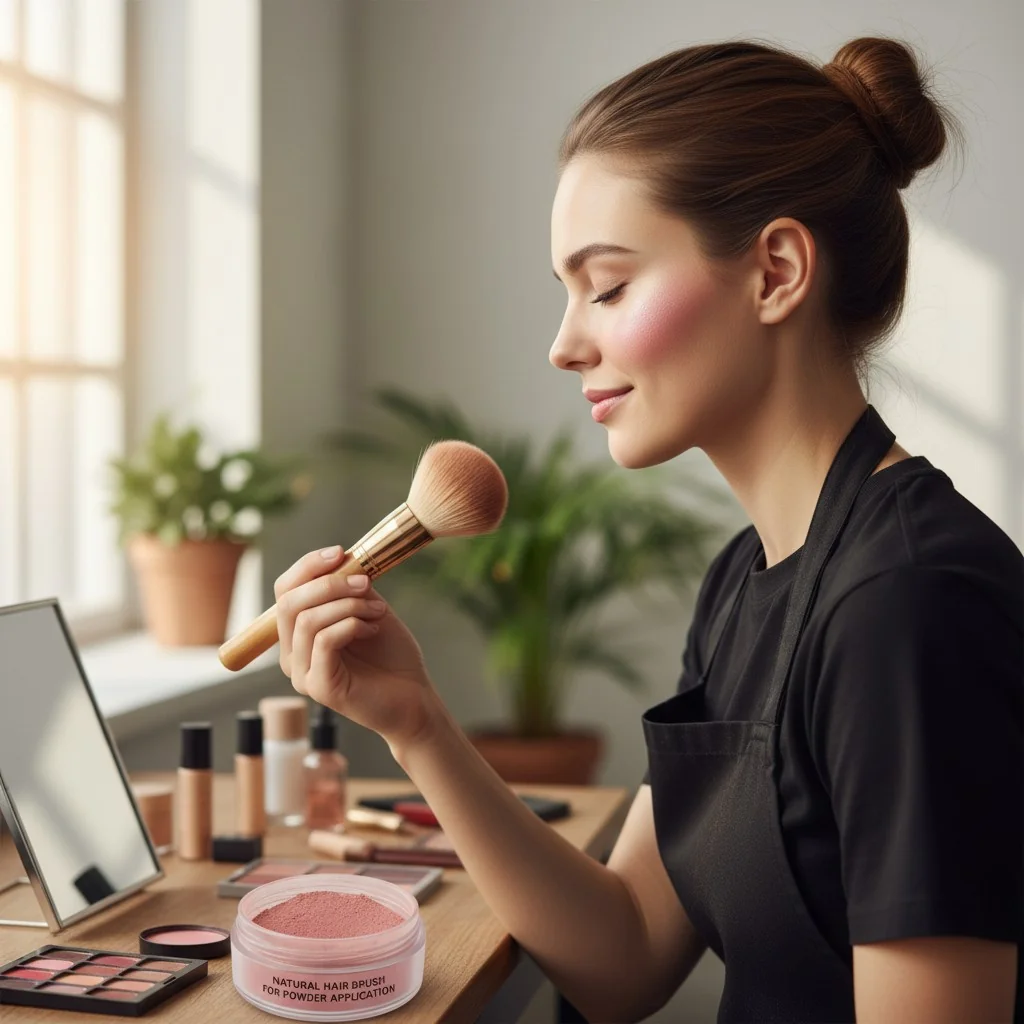
When you’re developing a product line, every component has to work together. A beautiful pressed powder can be ruined by a brush that doesn’t pick it up well. I’ve seen this happen. A brand invests heavily in a formula, only to get customer complaints about performance, when the real problem was the applicator they bundled with it. This is where understanding the fundamentals of brush fibers becomes a business advantage.
The Role of Cuticles in Performance
Natural hair fibers have a secret weapon: their Cuticles3. Think of them as tiny, overlapping scales along the hair shaft. These scales are perfect for grabbing and holding onto dry powder particles. When you sweep the brush across the skin, the powder is released smoothly and evenly. This creates that beautiful, airbrushed effect that’s hard to achieve otherwise. Synthetic fibers, on the other hand, are smooth and non-porous. They don’t absorb product, which makes them perfect for liquids and creams, as they deposit the product without soaking it up.
A Decision Framework for Your Brand
So, how do you decide? Here are the key factors I walk my clients through:
- Desired Finish: Do you want a soft, diffused look (choose natural for powders) or a precise, high-impact application (choose synthetic for creams and liquids)?
- Brand Claims: If "vegan" is a core part of your brand identity, you must use synthetic fibers. "Cruelty-free4" is more flexible, but you need to verify your supplier’s sourcing practices for animal hair.
- Cost: High-grade natural hair is a premium material and will increase your cost of goods. You need to balance this with your brand’s positioning and price point.
You should use a natural hair brush to apply liquid foundation for the best coverage.Faux
Natural hair is porous and will absorb a significant amount of liquid or cream product. This leads to product waste, potential streaking, and makes the brush difficult to clean. Smooth, non-porous synthetic fibers are far better for liquids.
The performance difference between natural and synthetic brushes is most noticeable with powder products like blush, bronzer, and eyeshadow.Vrai
The ability of natural hair cuticles to pick up and diffuse powder is its unique advantage. This results in a superior, seamless blend for powder formulas that even the best synthetics can struggle to replicate perfectly.
Which animal fibers fit each brush category?
Goat, squirrel, sable… the options are overwhelming. Picking the wrong fiber can result in a brush that feels scratchy, doesn’t apply product well, or doesn’t fit your brand’s luxury positioning.
Goat hair5 is a versatile workhorse for powders. Squirrel is ultra-soft for delicate finishing. Sable offers precision for liner and lip details. Pony hair is firmer and great for buffing. Matching the fiber to the application is the key to creating a high-performance brush.
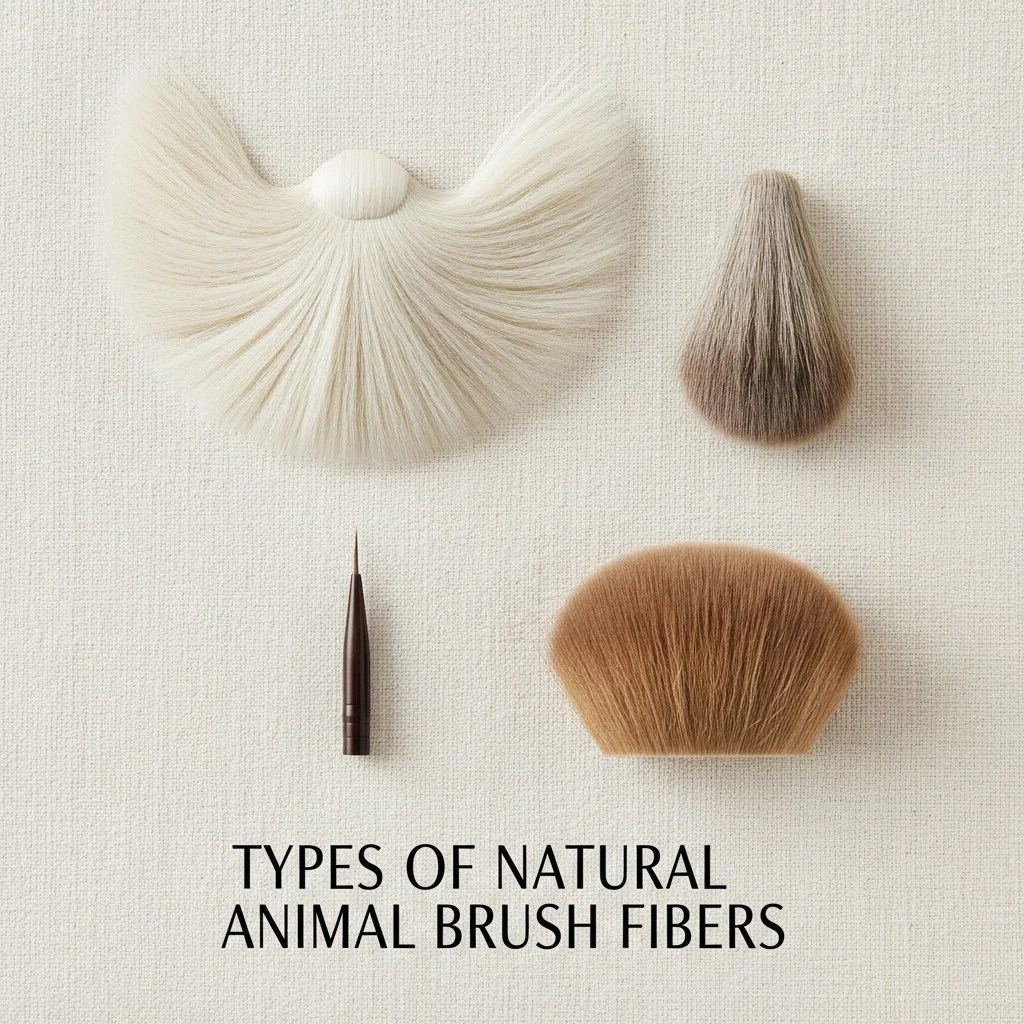
I always tell my clients to think of brush fibers like fabrics. You wouldn’t make a rugged backpack out of silk, and you wouldn’t make a delicate scarf out of canvas. The same principle applies to brushes. Each animal fiber has a unique texture, density, and resilience that makes it suitable for a specific job. Using the right one ensures the brush does its work effortlessly. Let’s look at the most common options we work with at the factory.
A Guide to Common Fibers
- Goat Hair: This is the most popular and versatile natural hair. It has a great balance of softness and strength, providing excellent pickup and blending for powders, blushes, and bronzers. It’s also available in different grades, like XGF (extra fine) or ZGF (top grade), which offer increasing levels of softness.
- Squirrel hair6: This is the pinnacle of softness. Squirrel hair is incredibly fine and delicate, with less "snap" or resilience than goat. It’s perfect for a sheer application of finishing powder or a whisper-light touch of highlighter. It’s a luxury fiber, ideal for premium brands.
- Sable/Kolinsky Hair: Valued for its strength, fine point, and resilience. Sable hair snaps back into shape perfectly, making it the top choice for detail work like eyeliner, lip color, and precise eyeshadow application.
- Pony/Horse Hair: These fibers are stronger and a bit stiffer than goat hair. This makes them durable and great for buffing in mineral foundation or applying dense bronzer. They hold their shape well and are often more affordable.
Fiber-by-Application Matrix
| Application | Goat Hair | Squirrel Hair | Sable/Kolinsky Hair | Pony/Horse Hair |
|---|---|---|---|---|
| Setting/Finishing Powder | ★★★ | ★★★ | ★ | ★★ |
| Blush/Bronzer | ★★★ | ★★ | ★ | ★★★ |
| Highlighter | ★★ | ★★★ | ★ | ★ |
| Eyeshadow Blending | ★★★ | ★★ | ★★ | ★★ |
| Eyeshadow Packing | ★★ | ★ | ★★ | ★★★ |
| Eyeliner/Lip Detail | ★ | ★ | ★★★ | ★ |
| Foundation Buffing | ★ | ★ | ★ | ★★ |
(★★★ = Ideal, ★★ = Good, ★ = Acceptable)
Squirrel hair brushes are the best choice for packing on intense, pigmented eyeshadow.Faux
Squirrel hair is extremely soft and has low resilience, making it ideal for a very sheer, light dusting of product. For packing on dense pigment, a firmer brush made of goat or pony hair is much more effective.
Goat hair is sorted into different grades, and a higher grade like XGF will feel significantly softer than a lower grade.Vrai
Yes, as a manufacturer, we grade goat hair based on softness, fineness, and which part of the animal it came from. Higher grades like XGF (Extra Fine Goat) and ZGF (Top Fine Goat) use the softest hairs, resulting in a more luxurious feel and smoother application.
Natural vs. synthetic: what about performance, care, and brand claims?
Vegan claims7 are trending, but you want the superior blending of natural hair. This conflict can stall your product development and confuse your marketing message. Let’s clear it up.
Natural hair offers unmatched powder blending, while synthetics give precision for liquids and are required for "vegan" claims. "Cruelty-free" can apply to both, but you must verify your sourcing. Your choice has to align with your brand’s core values and marketing strategy.
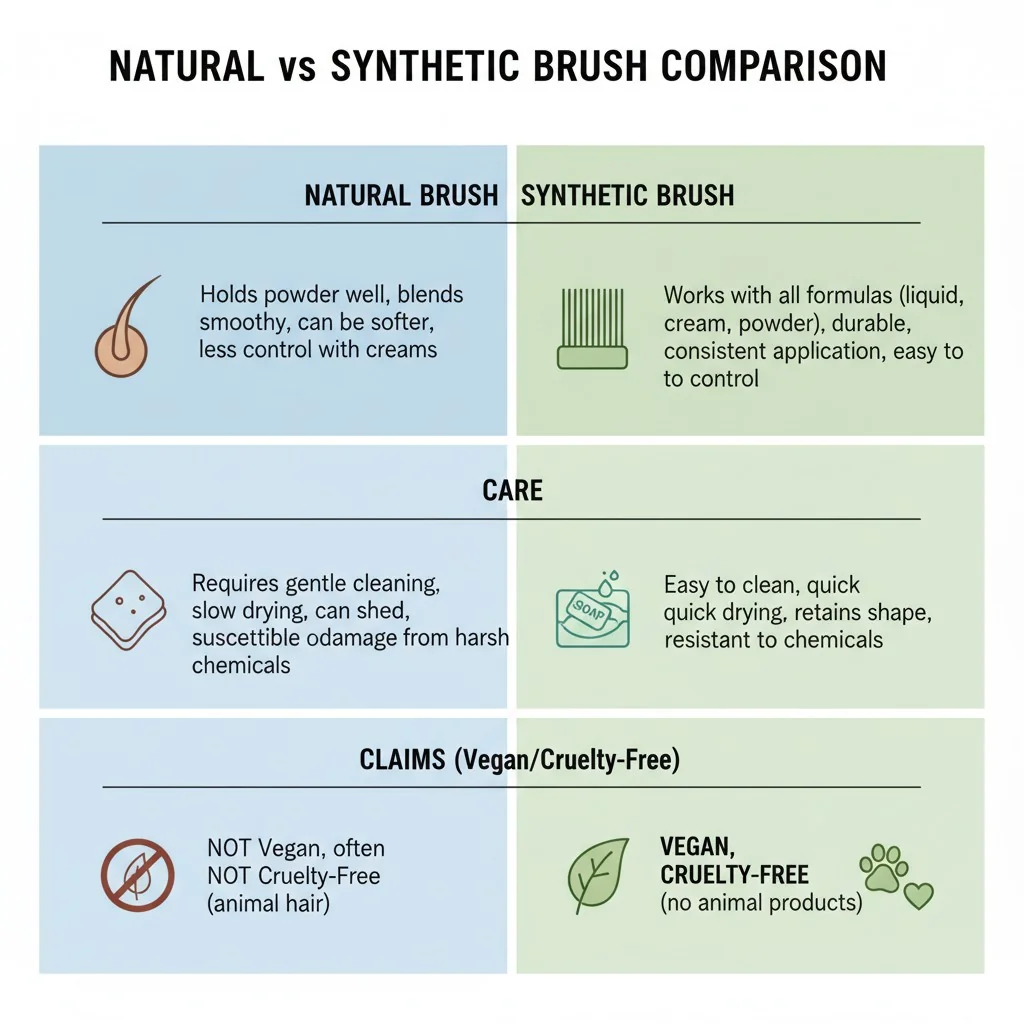
One of the biggest challenges for brand founders today is navigating the ethics and marketing claims around their products. Your customers are smart. They read labels and care about where their products come from. You can’t just say a brush is "good"; you have to be prepared to back up your claims, whether they’re about performance or ethics. This is especially true for brushes. Let’s put these two fiber types head-to-head so you can make an informed choice that aligns with your brand promise.
Performance, Care, and Cost
The right choice often comes down to a few key trade-offs. While modern synthetics have improved dramatically—some new fibers even mimic the softness of goat hair—there are still core differences. Natural hair’s superior blending for powders comes at the cost of more delicate care. Synthetics are durable and easy to clean but may not provide that same flawless, diffused finish with powders.
Natural vs. Synthetic: A Quick Comparison
| Fonctionnalité | Natural Hair Brushes | Synthetic Brushes |
|---|---|---|
| Best For | Powders (blush, bronzer, eyeshadow) | Liquids & Creams (foundation, concealer) |
| Performance | Superior pickup & seamless blending | Precise application, no product absorption |
| Feel | Soft to ultra-soft, luxurious | Can range from stiff to very soft |
| Care | More delicate; gentle cleaning, lay flat to dry | Durable; easy to wash, quick-drying |
| Cost | Generally higher, especially for premium grades | More affordable, consistent pricing |
| Vegan Claim | No | Yes |
| Cruelty-Free Claim | Yes (with verified ethical sourcing) | Yes |
Aligning Claims with Your Brand
This is critical.
- Vegan: This is non-negotiable. If your brand is vegan, you must use 100% synthetic fibers.
- Cruelty-Free: This claim means your products were not tested on animals. A brush using sheared goat hair can be labeled "cruelty-free" if the supplier can document that the animals were not harmed in the collection process. Always ask your manufacturer for this documentation. Be transparent with your customers about what your claims mean.
A 'cruelty-free' makeup brush is always vegan.Faux
These terms are not interchangeable. 'Cruelty-free' refers to a lack of animal testing. A brush can use ethically sourced animal hair (like sheared goat) and be cruelty-free. 'Vegan' means the product contains zero animal-derived ingredients, so it must be synthetic.
New synthetic fiber technologies allow them to mimic the performance of natural hair for powder application.Vrai
This is true. Through advanced extrusion and tip-processing techniques, manufacturers can create synthetic bristles with textured surfaces that significantly improve their ability to pick up and blend powder, closing the performance gap with natural goat hair.
How do you handle B2B sourcing and QC for natural hair brushes?
You’ve chosen your fiber, but how do you guarantee quality from a factory overseas? Without a clear QC plan, you risk receiving a batch of shedding, inconsistent, or poorly assembled brushes that will damage your brand.
For B2B sourcing, you must provide clear specifications for Fiber grade8 (e.g., goat XGF), tuft density, and ferrule material (brass is best). Implement QC tests for shedding, product pickup, and pull strength. Understand how MOQ, materials, and finishes impact your total cost and lead times.

This is where my experience on the factory floor becomes so valuable for the brands I partner with. Getting a perfect sample is one thing; ensuring that all 5,000 units in your bulk order match that quality is another. The only way to do this is with a clear, non-negotiable Quality Control (QC) protocol. Vague instructions like "make it soft" are not enough. You need to speak the language of manufacturing to get the results you want.
Key Quality Specifications to Provide
When you send a tech pack to a manufacturer, be specific:
- Fiber Grade: Don’t just say "goat hair." Specify the grade (e.g., "XGF Grade White Goat Hair").
- Tuft & Density: Define the brush head shape, dimensions, and desired density.
- Hardware: Specify the ferrule material (I recommend seamless brass for durability) and handle material, weight, and finish.
Essential QC Validation Checklist
Your manufacturer should agree to perform these tests:
- Shedding Test: Count the number of hairs lost after the first 3 washes. The number should be minimal.
- Pickup/Laydown Test: Use a standardized amount of powder to test how well the brush picks it up and applies it.
- Ferrule Pull Test: The ferrule (the metal part) should withstand a specific amount of force without detaching from the handle.
- Wash Cycle Test: The brush should retain its shape and integrity after a set number of wash-and-dry cycles.
- Hygiene Check: Ensure brushes are clean and free of residues or bioburden before packaging.
Navigating Procurement
Finally, think like a sourcing manager:
- MOQ: Ask about Minimum Order Quantities. At Brushino, we offer low MOQs to help indie brands get started.
- Cost Drivers: Understand that fiber type, grade, ferrule metal, handle finish, and printing all affect the final price.
- Documentation: Request all necessary certificates for your claims (e.g., ethical sourcing for cruelty-free animal hair, FSC for wood handles).
The Minimum Order Quantity (MOQ) for custom makeup brushes is always fixed and non-negotiable with factories.Faux
While many large factories have high, rigid MOQs, flexible partners like Brushino exist to support growing brands. We often provide low MOQ solutions to help you launch without the risk of overstocking.
A brass ferrule is a better choice than an aluminum one for a high-quality makeup brush.Vrai
Absolutely. Brass is stronger, heavier, and more resistant to corrosion and denting than aluminum. It allows for a tighter, more secure crimp on the bristles, which dramatically reduces shedding and ensures the brush lasts longer.
Care and maintenance standards for professional use
To ensure your natural hair brushes last, proper care is essential. Always use a gentle brush cleaner or baby shampoo. After washing, gently squeeze out excess water, reshape the bristles, and lay the brush flat to dry. Never dry them upright, as water can seep into the ferrule and loosen the glue. Avoid high heat. For luxury brushes, occasionally combing the bristles can help maintain their shape and softness.
Building a hybrid set for broad customer appeal
You don’t have to choose one or the other. The most successful brush lines I’ve helped create often feature a Hybrid set9. This strategy allows you to offer the best of both worlds. Include flawless natural hair brushes for powders (blending, blush, finishing) and high-performance synthetic brushes for liquids and creams (foundation, concealer, eyeliner). This approach caters to all customer preferences and showcases your brand’s expertise in tool curation.
Brand benchmarking and positioning cues
Look at what the luxury leaders are doing. Brands like Hakuhodo, Chikuhodo, and Sonia G. are masters of natural hair brushes. They built their reputations on the unparalleled softness and blending capabilities of high-grade goat and squirrel hair. Notice how they position these as investment pieces. This can inspire your own strategy for a premium, performance-focused brush line that commands a higher price point and builds a loyal following.
FAQs for B2B Buyers?
-
What’s the difference between XGF and ZGF goat hair?
ZGF (Zoshuho) is a top-tier, extremely soft grade of goat hair, while XGF (Saikoho) is also a premium, very soft grade, just slightly below ZGF. Both are excellent for luxury powder brushes. -
Can a natural hair brush be "cruelty-free"?
Yes. If the hair is sourced via methods that do not harm the animal, like shearing a goat, and your supplier provides documentation, you can claim it is "cruelty-free." -
How do I test a brush sample for quality?
Rub it on your skin to check for scratchiness. Test it with the intended product for pickup/laydown. Wash it to check for shedding and shape retention. Pull firmly on the ferrule to test its bond to the handle. -
What is the most common reason for brush shedding?
Poor glueing inside the ferrule or using a low-quality ferrule (like aluminum) that doesn’t crimp tightly enough are the top two manufacturing defects that cause shedding. -
Why is a brass ferrule better?
Brass is stronger, heavier, and more corrosion-resistant than aluminum. It ensures a secure crimp, preventing shedding and giving the brush a more balanced, premium feel. -
How does MOQ affect my final price per brush?
Generally, a higher order quantity will result in a lower price per unit, as it allows the factory to optimize material purchasing and production runs. -
What documentation should I ask for to support a "vegan" claim?
You need a material specification sheet from your manufacturer that explicitly states the bristles are 100% synthetic (e.g., PBT, nylon) and contain no animal-derived components. -
How long should a quality natural hair brush last?
With proper care, a well-made natural hair brush can last for many years, often becoming even softer and better with time. -
What’s the best way to clean natural hair brushes?
Use a gentle soap (like baby shampoo) and lukewarm water. Swirl the bristles in your palm, rinse thoroughly, gently squeeze out water, reshape the head, and lay it flat to dry. -
Can you create a hybrid set with both natural and synthetic brushes?
Absolutely. This is a popular and smart strategy. We can work with you to design a custom set that uses the best fiber type for each specific application.
Conclusion
Choosing the right brush fiber is a strategic brand decision. This guide gives you the factory-level insights to select materials, validate quality, and align your brushes with your brand’s promise.
Références
-
Learn about the performance differences and ideal uses for synthetic brushes in makeup. ↩
-
Explore the unique advantages of natural hair brushes for achieving flawless makeup application. ↩
-
Understand how cuticles enhance the application of powder products for a seamless finish. ↩
-
Understand the significance of cruelty-free labeling and ethical sourcing in the beauty industry. ↩
-
Discover why goat hair is favored for its versatility and performance in makeup application. ↩
-
Find out why squirrel hair is considered the pinnacle of softness and quality in brushes. ↩
-
Explore the requirements for making vegan claims and the importance of transparency in sourcing. ↩
-
Learn about the impact of different fiber grades on brush performance and customer satisfaction. ↩
-
Discover how a hybrid set can cater to diverse customer needs and enhance your product line. ↩

